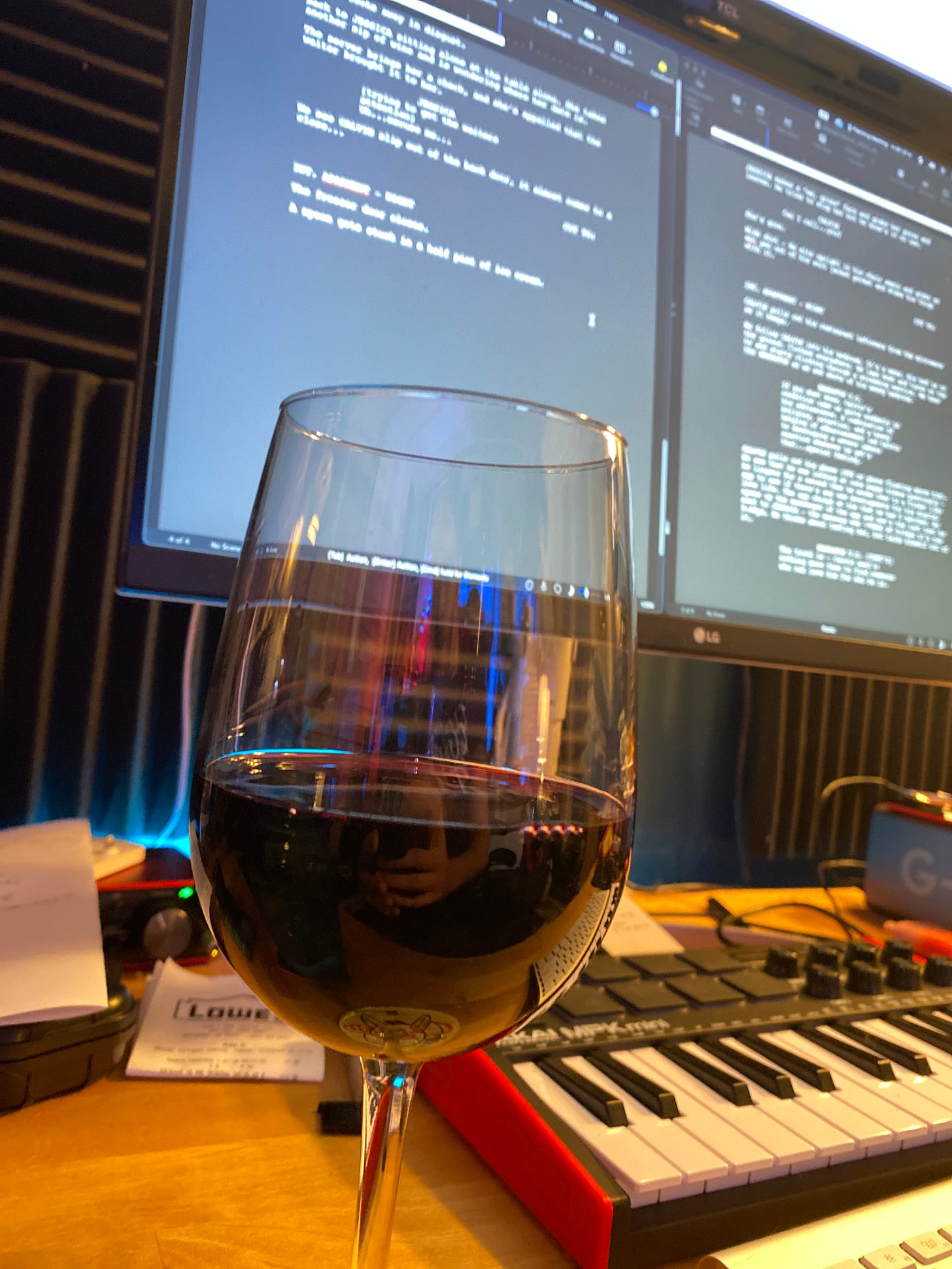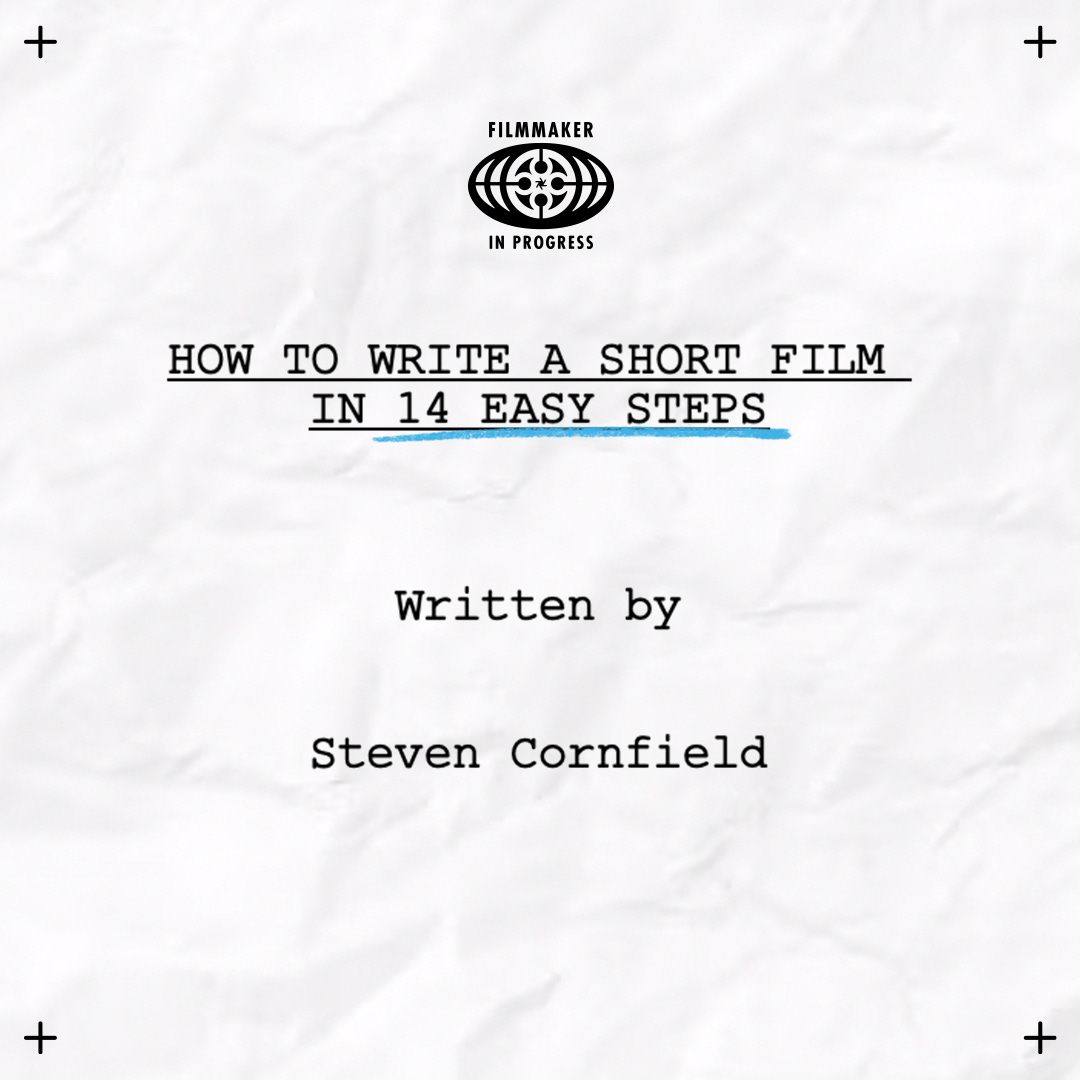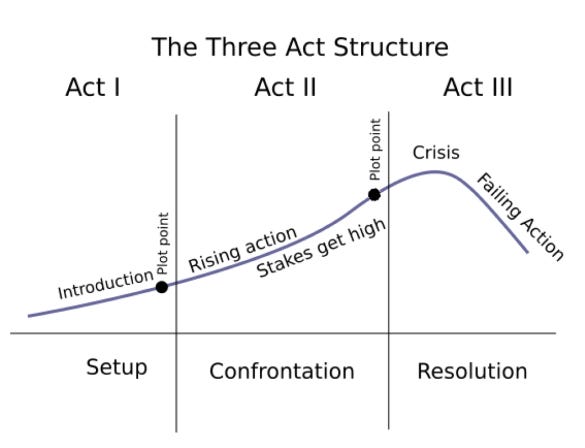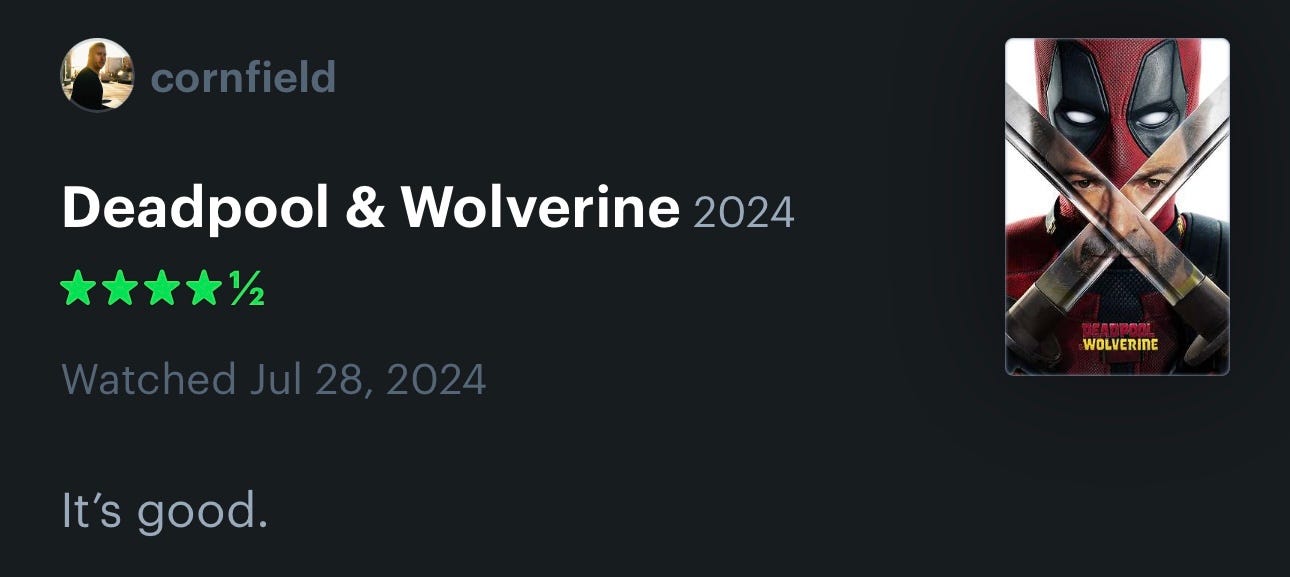So let’s talk about making a short film.
I call this Filmmaker in Progress - so let’s talk about the progress of becoming a filmmaker shall we? I want to make a series of a few posts diving into each part of an honest look into what went into the making of my first short film.
First up: Writing
Writing hasn’t always been my strong suit. I’ve enjoyed it immensely and even back in the day I was a blogger (who made no money, but still a good experience - RIP These Old Colors).
“I’m not a good writer” I would tell myself, but I would always still feel a certain draw towards writing. There’s something about it. Coming up with stories, the idea of “world building”, and tapping into the imagination to come up with something that never existed before. I have countless ideas I’ve written the last 15 years, but never really fleshed anything out. Only just rough outlines or ideas collecting dust in my file cabinet. I always saw myself more as a “visual artist” than a writer.
But back in 2021 - I was having a good year in my video production business. I started directing more commercials and making bigger films - but there was a voice inside my head that made me really want to do something for myself. 2 for them - 1 for you right?
So - let me paint the scene - I’m in Mexico - I was finishing up another commercial I directed and edited at that time on vacation - but also felt the need to write something for myself.
But what do I write?
Honestly - none of my ideas from before were really jiving with me. I wanted something funny, but with a point, but also serious, and a good theme. With good music, and good visuals.
Then it hit me: an idea I heard from my brother about 10+ years prior. The one sentence concept of “a guy who is allergic to love”.
I remember where I was when I remembered this idea - sitting on the sofa in our airbnb in Sayulita, Mexico while everybody was in the pool right outside. Immediately I saw the vibe, heard the music, colors started popping up in my head. I texted my brother if I could use his idea to start writing it - and he gave me the go ahead.
Cool. Idea secured.
So what did I do first? For sure just write something, right? Nope.
Step #1: Make a Spotify Playlist
I always make a playlist for a new project. I compile songs when I’m pitching commercials or just fleshing out an idea for myself.
I knew exactly the feel I was going for with “allergic to love” (at that moment I was calling it “The Hopeful Romantic”): whimsical, fantastical, and cute. I knew it had to be all orchestral instruments - no electronic synths or big drum moments. So I scoured Spotify for the right music, and here’s what I came up with:
Ok, cool. Now I have a soundtrack to write to. A very crucial part in the process done.
Now, for actually writing the script - I had the concept - but what happens in the story? What do I want to actually say?
I was looking forward to writing - stretching my imagination - being creative, but now I was met with so many different options of what I could do.
STEP #2: Write down Some Ideas
This was my stream of consciousness part. I literally opened up a Google Doc while still in Mexico and went to town. Some of it was good - most of it was shit. Speaking of shit - I had been poisoned by Mexico, so I took the time of being stuck in my room to write. TMI, but I just want to give you the full image of my process.

I wrote as much as I could while listening to the soundtrack I made in between bathroom trips.
From this process I knew I wanted an old story time narrator (in the vein of Pushing Daisies or 500 Days of Summer), and I knew I wanted it to be a little silly and weird (the concept is wild so let’s lean into that).
I would send this Google Doc to my brother, and he would give his notes. I’d write some more based off of those notes. We went back and forth for a while even after vacation.
I had my music, ideas were flowing, and now I had to condense everything into a cohesive story.
Soooooo…how do I do that? Oh yea…Google.
Step #3: Google Story Structure’s
I literally Googled “short film story structures” and you know what I found?
Too much.
There’s so many ways to structure a story and I got a little overwhelmed, but I ended up gravitating towards the OG of story templates - the 3 act structure.
Also, I knew I wanted 4 things in the script:
I wanted it to be about 1 guy. Being a guy myself - I wanted to be able to put my own characteristics and experience into the character.
There has to be a love interest. He’s allergic to love right? There has to be love in it somewhere.
I wanted a “guide” - a person that pushes him out of his comfort zone into a new comfort zone. Could be a best friend? A roommate?
A big outburst of an allergic reaction
Ok so 3 characters. A funny moment. 3 acts. Cool. This is easy so far.
I started seeing visuals of scenes, but had no idea how they connected.
I just had to write it all out. So on to writing! Here we go!
Step #4: Figure Out What Script Writing Software To Use
Oooook. I need to figure out where I’ll write the actual script, right? I don’t want to keep writing in Google Docs. Ok, let’s figure out what I’m gonna use.
I tried Highland, Fade In, Celtx, used Arc Studio for a bit, but finally landed on Final Draft, mostly just because everybody “big” uses Final Draft.
Ok NOW I’m ready. I have my idea, my playlist is solid, my outline feels good, my writing software…it’s finally time to…
Step #5: YouTube Videos and Podcasts on How To Write a Short Film
FOR FUCKS SAKE! Just get on with it and put some words on paper. Stop procrastinating. It’s gonna suck, why put off the inevitable.
Well…I have to know the best way to tackle such a big project right? Maybe people who have done it before me can give me some insights on best practices. I do want to make sure I’m doing it the right way.
To speed this up - here’s 2 videos I watched during this step:
I did listen to these podcasts as well:
OK! Now it’s time to put those fingers on the keyboard and…
Step #6: Outline Everything
FINALLY! Time to sit down and write. Well sort of. We’re getting there. Slowly.
I took all my ideas and notes from earlier, and just started typing up a rough outline. It included rough dialogue, actions, camera shots, scenes, about as much as I could come up with. It was a little bit of a process, because although I had the basics of the story I wanted to tell, I was missing a few pieces that connected. So outlining was good to get it all out and visualize what everything will look like.
Alright…now that that’s done. Is it time yet? To actually write something?
Yes.
Step #7: FIRST DRAFT!
Staring at a blank screen is intimidating. That taunting blinking slash waiting for you to actually write something.
You just have to do it. Write something. It doesn’t have to be amazing. Just get those ideas out.
To say I had a great first draft would be a lie.
It was truly awful.
If I remember - it was messy and way too many locations for a short film. The dialogue was “eh”, I went to far in the “whimsical” direction, too many characters (I went way past 3), too many moments I didn’t need, the list goes on.
I also blatantly ripped off some of my inspirations. It happens. As Austin Kleon wrote in his book “Steal Like an Artist”:
Start copying what you love. Copy copy copy copy. At the end of the copy you will find your self.
Ok, so I might have took some stuff from things I liked, but we’re on the way.
And here’s the thing - it was done. Yes it was bad - and yea, I totally freaking cringed when I read it back, but it was done.
Now to get serious…
Step #8: Rewrite
This is the part where it get’s tedious and monotonous.
Combing over each page for issues or problems or things to make better. Changing moments or little bits of dialogue, or even entire character arcs.
Questioning everything. Why is this here? Do we need it? Why do they say this? Is it necessary?
Dammit.
Actually…this isn’t good at all. Time to open a new document.
Step #9: Delete Everything and Start Over, but This Time Simplify Everything
Yep.
Time to redo everything. Strip the fat of what wasn’t working in that first draft, keep what was, and fill in the cracks.
Step #10: Overthink Decision To Simplify Everything
But wait…if I lose that part then that changes the ending? Or if I take that character out I lose that cool piece of dialogue I really liked.
SHIT! This is tougher than I thought.
Step #11: Stay Up Late With a Bottle of Red Wine That Your Wife Was Saving for a Special Occasion and Rewrite The Entire Script
Open up Final Draft.
Start a new document.
This is the last time.
Fuck it, let’s do it in one night. Red wine? Hell yea.
To quote my DP on this project, Quinton:
“There’s something about writing and red wine that go so well together.”
Ain’t that the truth.

This was actually super fun to do (I did it more than once). Hitting a flow state with a glass of red wine next to you is probably on my top 20 all time favorite things to do. Since I had been writing this for so long, these moments really helped to loosen me up and just not overthink too much. I’m not condoning drinking a whole red bottle to yourself to do this every time, but for me…it helped here and there with my overthinking. Characters started making decisions that I didn’t see coming, moments started clicking together, scenes started to come to life…
Oh, shiiiiiiit - it’s 4am. Time for bed.
Wake up, read it all over. Hey, this isn’t half bad. A few typos here and there, clean up some things, but overall…this is looking ok.
Step #12: Muster up the Courage and Ask for Feedback From Friends; Rewrite Again
Ready for feedback? I bet your brain isn’t. Cause mine for sure wasn’t.
I had been pouring over this screenplay for so long that I didn’t realize how attached I was to what I wrote.
What I really wanted everybody to say: “Yo! This is phenomenal! You’re the best writer in the world! Here’s your Oscar!”
What they really said: “This part didn’t make sense”, “You lost me at this moment”, “I feel like you could lose this scene entirely - it doesn’t add anything to the film” “I don’t get it”.
Ok, ok, ok. Just breathe. Take the notes. They’re only there to help you. Climb out of the box you’ve been in and look at everything from a new lens. You have the ability to take the notes or not - it’s your script - not theirs. Choose what resonates with you and rewrite.
We’ll wait.
Done already?
Let’s read it again, but this time with a clear mind.
The script is a lot cleaner and tighter now right? The main characters actually feel real and are making decisions that seem to be on their own. You understand what they would actually do in the situation you put them in.
This is the final version for sure. For sure.
Step #13: Rethink and Rewrite the Ending, Days Before Filming
Yes, this happened.
You know how it happened?
I got all the department heads for the film together for a dinner to discuss production, and we started talking about the story. This was less than a week away from our first day of filming.
And god bless her heart - our Art Director, Jordan Bird, came out right and said “I don’t like the ending.”
Ok, don’t panic. Hear her out.
She went on to explain why she didn’t like it, and even gave an idea that would even make the ending better.
Wo, I love that actually.
And so I went home and wrote it in, and that’s the ending that made it into the movie.
Lesson learned: Be willing to take other people’s ideas, and take yourself out of it. The script can change up until the moment that it’s on film. Sometimes your ideas aren’t always the best.
Step #14: Stop Writing and Be Proud of Yourself for Finishing
Pencils down!
We did it! What a freaking journey!
A 2 year journey actually, and over 11 versions from that “final version”.
When I look back at the beginning of writing this, and if I was able to see the future on how long it really took, I probably would have never finished it.
But now - that I did, and it’s done, and filmed - I’m proud of myself for sticking to it. It makes the next one even easier now that I have a 14 step template to follow.
It was easy for my brain to make up excuses on procrastinating the actual work, because this was one of the biggest things I’d ever done, but our brains love how our life is right now. It doesn’t like the uncomfortable of the unknown, so it puts other things in the way that seem important at the time, but in reality, isn’t.
Good luck on your writing journey, and hopefully you found some inspiration in this to help keep you going.
One movie I watched recently:
One thing that inspired me:
I can’t get enough of VFX Artists React by Corridor Crew. It’s become my comfort watch. I love seeing behind-the-scenes stuff and to watch these guys reacting to good and bad vfx art makes me feel like I’m on the couch watching the movie with them.







